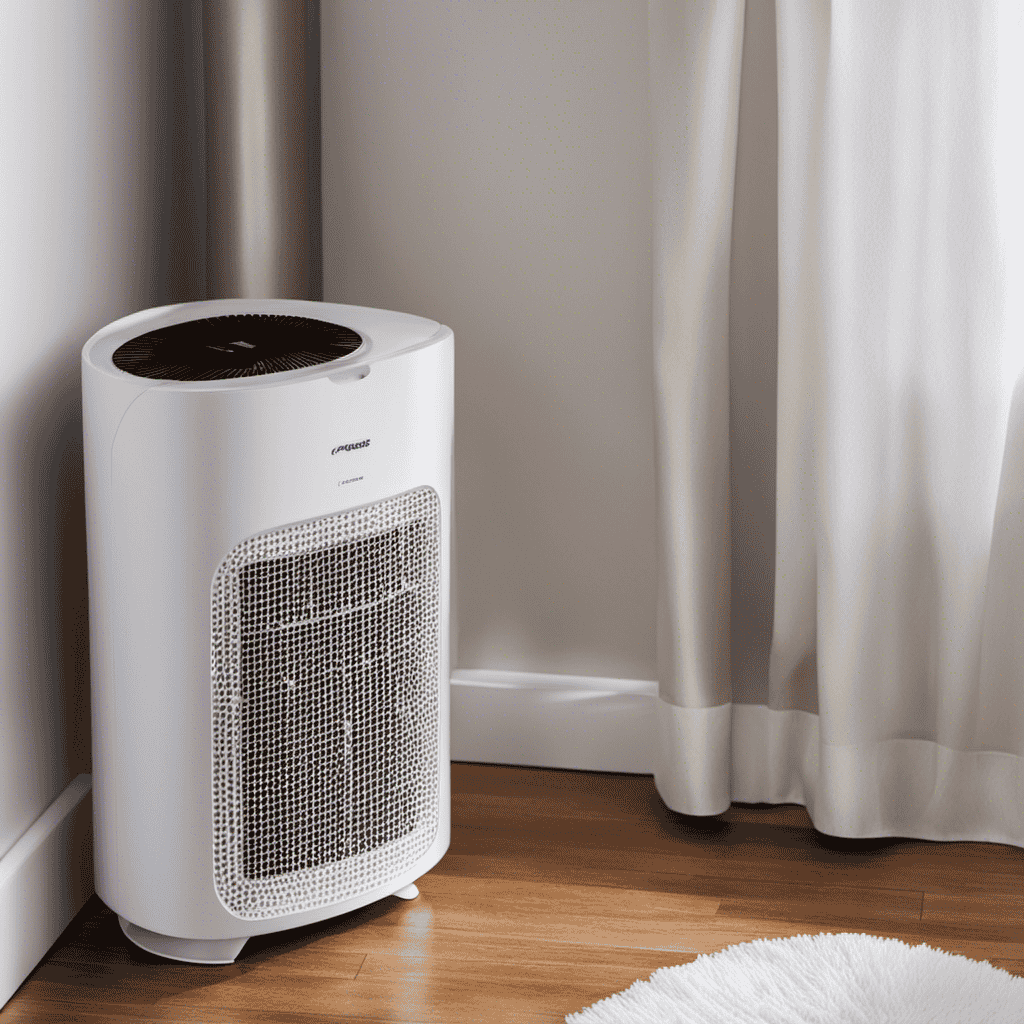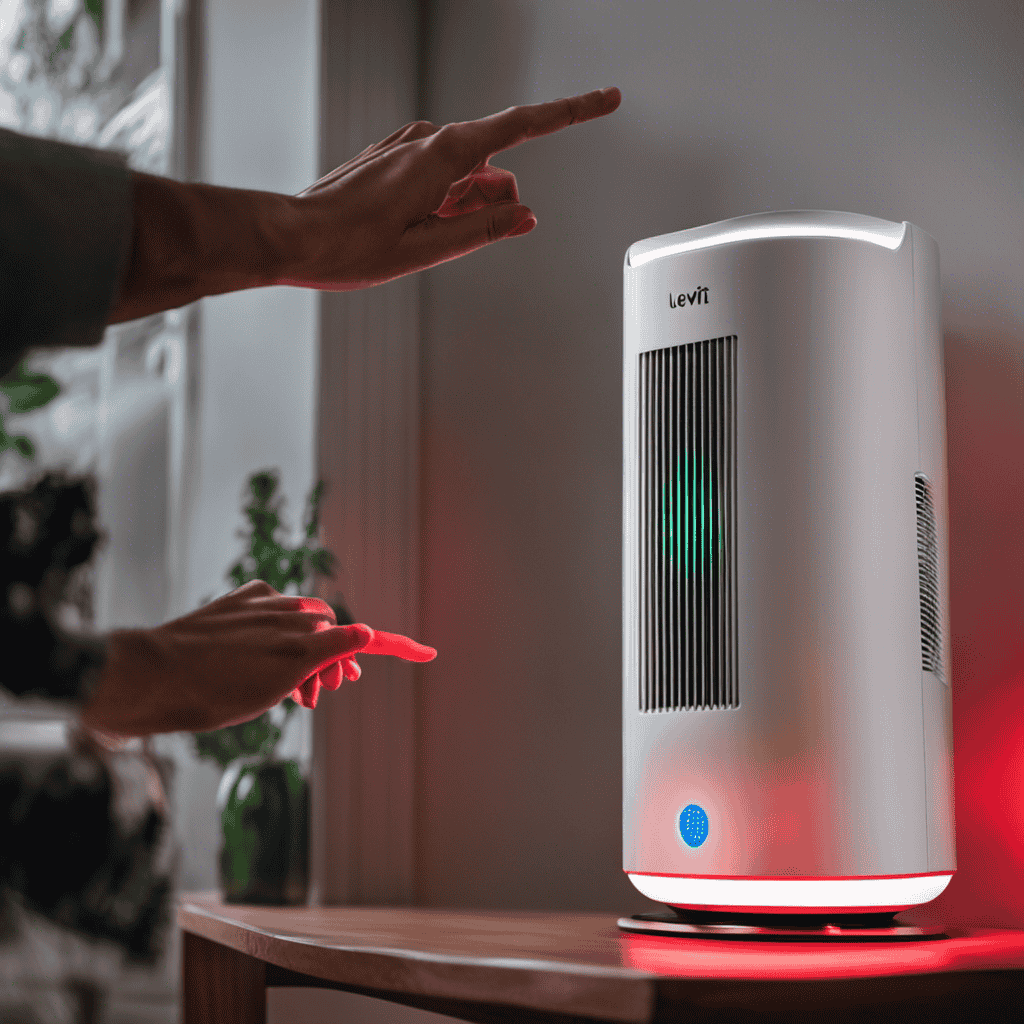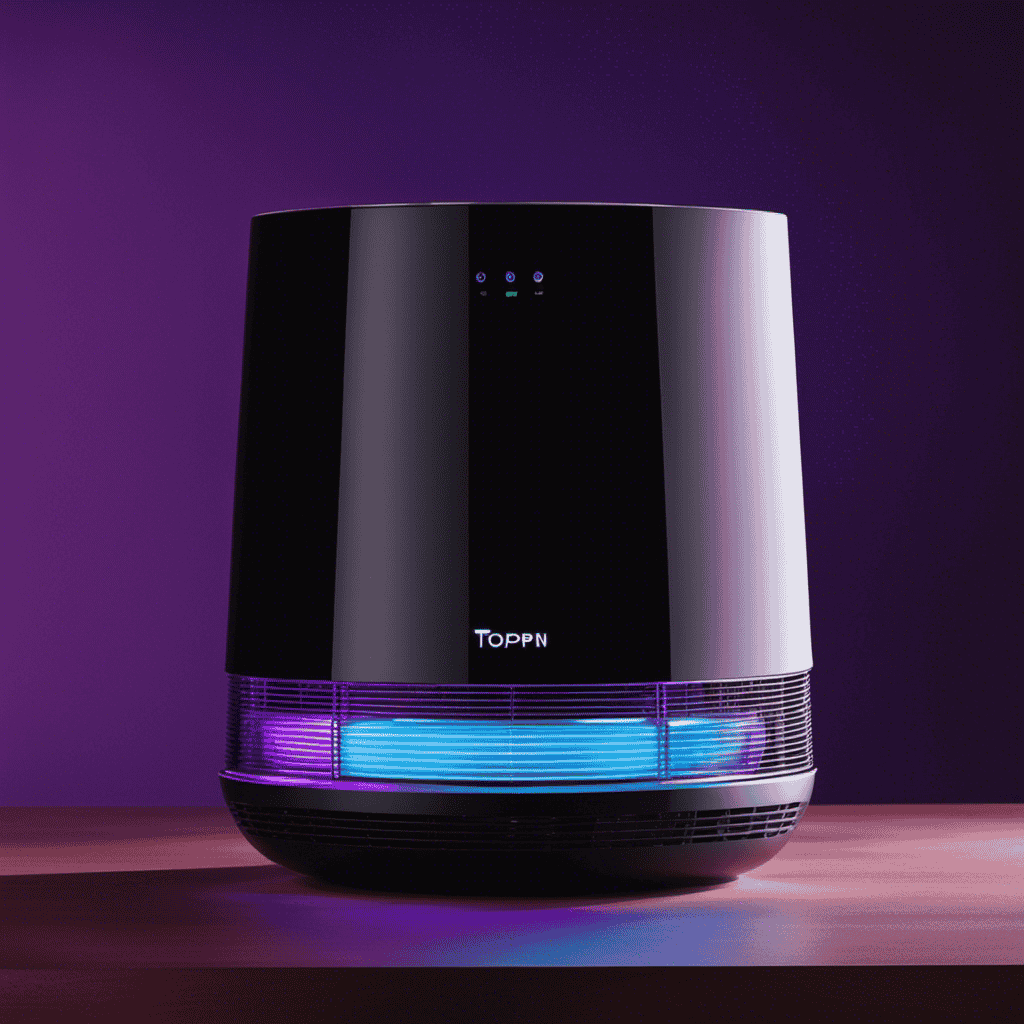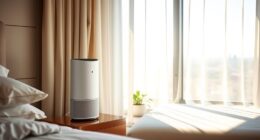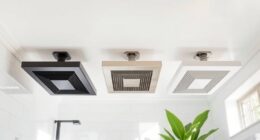As I dive into the world of air purifiers, I realize the key to their effectiveness lies in keeping them clean. In this guide, I will walk you through the process of cleaning your air purifier, step by step.
We’ll start by understanding why cleaning is so important, gather the necessary supplies, and then dive right into the cleaning process.
By the end, you’ll have a refreshed and efficient air purifier ready to improve the quality of the air in your home.
So let’s get started!
Key Takeaways
- Regular maintenance and cleaning are essential for optimal functioning and efficiency of air purifiers.
- Different types of air purifiers may require different cleaning techniques, so it’s important to follow the manufacturer’s instructions.
- Cleaning the filters, fan blades, vents, and control panel regularly ensures effective air filtration and prevents dirt accumulation.
- Proper drying and reassembly after cleaning, along with regular cleaning routines, can extend the lifespan of filters and maintain the purifier’s performance.
Understanding the Importance of Cleaning Your Air Purifier
You need to understand why it’s important to clean your air purifier regularly.
Regular maintenance of your air purifier is crucial to ensure its optimal functioning and efficiency in purifying the air in your home. Over time, the filters in the air purifier can become clogged with dust, pollen, pet dander, and other airborne particles. This can reduce the purifier’s effectiveness and lead to poor indoor air quality.
Cleaning your air purifier regularly can help prevent this buildup and ensure that it continues to effectively filter the air in your home. The cleaning techniques for different types of air purifiers may vary, but generally involve removing and cleaning the filters, wiping down the exterior, and occasionally replacing worn-out filters.
Following the manufacturer’s instructions is important to maintain the performance and longevity of your air purifier.
Gathering the Necessary Supplies for Cleaning
To get ready for cleaning, make sure you have all the supplies you’ll need. Here are the proper cleaning techniques and effective cleaning tools for cleaning your air purifier:
-
Soft cloth: Use a soft cloth to wipe down the exterior of the air purifier. This will remove any dust or dirt that has accumulated on the surface.
-
Brush attachment: Attach a brush to your vacuum cleaner to gently clean the vents and grills of the air purifier. This will remove any dust or debris that may be blocking the airflow.
-
Mild detergent: Mix a small amount of mild detergent with water and use this solution to clean the filters of the air purifier. Rinse thoroughly and allow them to dry completely before reinserting them.
-
Compressed air: Use compressed air to blow out any dust or debris that may have accumulated inside the air purifier. This will help to maintain optimal performance.
Turning Off and Unplugging Your Air Purifier
When it comes to turning off and unplugging your air purifier, it is important to prioritize safety precautions. Before unplugging, ensure that the power is turned off and the unit has completely shut down. This will prevent any potential electrical hazards.
Additionally, after cleaning your air purifier, it is crucial to store it properly to maintain its efficiency and prolong its lifespan. Keep it in a cool and dry place, away from direct sunlight and any potential sources of damage.
Safety Precautions for Unplugging
Before unplugging your air purifier, make sure to turn off the power switch. This is an important safety precaution to prevent electrical accidents.
When it comes to safe storage practices, here are a few key points to keep in mind:
- Store your air purifier in a cool, dry place to prevent moisture damage.
- Avoid storing the purifier near flammable materials or in areas with excessive heat.
- Keep the purifier away from children and pets to prevent accidents or damage.
- If you need to transport the air purifier, make sure to secure it properly to prevent any damage during transit.
Proper Storage After Cleaning
After cleaning, it’s important to store your air purifier in a cool, dry place to prevent any potential damage. Proper storage is a crucial step in maintaining the longevity and efficiency of your device.
To ensure optimal performance, follow these best practices. Firstly, make sure the air purifier is completely dry before storing it. Any residual moisture can lead to mold or mildew growth.
Secondly, remove and clean the filters according to the manufacturer’s instructions. This will prevent any buildup of dust or debris during storage.
Lastly, cover the air purifier with a clean cloth or plastic bag to shield it from dust or accidental damage.
Removing and Cleaning the Pre-Filter
To clean the pre-filter of your air purifier, you should first unplug the device and remove the filter from the unit.
The pre-filter is an essential component that captures larger particles such as dust, pet dander, and pollen.
Here’s a step-by-step guide to properly maintain your pre-filter:
- Gently remove the pre-filter from the air purifier.
- Shake off any loose debris or dirt.
- Use a soft brush or vacuum cleaner attachment to remove stubborn particles.
- If the pre-filter is heavily soiled, rinse it with water and mild soap, then let it air dry completely.
Regular pre-filter maintenance is crucial to ensure optimal performance and prolong the lifespan of your air purifier. By following these simple steps, you can keep your air purifier operating efficiently and enjoy cleaner, fresher air in your home.
Cleaning the HEPA Filter
When it comes to maintaining the efficiency of your air purifier, proper filter maintenance is crucial. To ensure optimal performance, here are some helpful tips to keep in mind.
Additionally, understanding the recommended cleaning frequency guidelines for your specific filter type will help you maintain a cleaner and healthier indoor environment.
Filter Maintenance Tips
Regular filter maintenance is crucial for keeping your air purifier working effectively. Neglecting filter maintenance can lead to common filter problems, such as reduced airflow and decreased filtration efficiency.
To extend the lifespan of your filters, here are some tips to follow:
- Check your filters regularly for any signs of dirt or dust accumulation.
- Vacuum or brush off the surface of your filters to remove loose particles.
- If your filters are washable, gently clean them with water and mild soap, then allow them to dry completely before reinstalling.
- Consider using a pre-filter to capture larger particles and protect your main filter from clogging.
Cleaning Frequency Guidelines
Cleaning your filters on a regular basis is important for maintaining the effectiveness of your air purifier. The frequency at which you should clean your filters depends on several factors, including the type of filter and the air quality in your home.
Generally, it is recommended to clean the pre-filter every 2-3 months, the HEPA filter every 6-12 months, and the activated carbon filter every 12-18 months. However, it is important to note that these are just general guidelines and may vary depending on your specific circumstances.
To determine the ideal cleaning schedule for your air purifier, refer to the manufacturer’s instructions or consult with a professional. Keeping up with a regular maintenance schedule will ensure that your air purifier continues to effectively remove pollutants from the air in your home.
Speaking of filters, let’s now move on to cleaning the activated carbon filter.
Cleaning the Activated Carbon Filter
To effectively clean the activated carbon filter, you should first remove it from the air purifier. This is an important step to ensure thorough cleaning and maintenance of your filter.
Here are some simple steps to follow in order to clean your activated carbon filter:
- Gently tap the filter to remove any loose debris or particles.
- Rinse the filter under running water to remove any dirt or dust.
- Use a mild detergent or activated carbon filter cleaner to remove any stubborn stains or odors.
- Allow the filter to air dry completely before reinstalling it into the air purifier.
Regularly cleaning your activated carbon filter is essential for maintaining its effectiveness in removing odors effectively. By following these steps, you can ensure that your filter remains clean and performs optimally, providing you with clean and fresh air in your home.
Cleaning the Ionizer or UV-C Light
If you want to maintain the effectiveness of the ionizer or UV-C light, it’s important to regularly clean them.
Cleaning the fan blades and maintaining the air purifier’s motor are crucial steps in ensuring that these components continue to work efficiently.
To clean the fan blades, first, make sure the air purifier is turned off and unplugged. Use a damp cloth or sponge to gently wipe away any dust or dirt that has accumulated on the blades. Be careful not to bend or damage the blades during this process.
As for the motor, refer to the manufacturer’s instructions for specific cleaning recommendations. In general, you can use a soft brush or vacuum attachment to remove any debris that may have settled on the motor.
Regular cleaning of these components will help your air purifier continue to effectively purify the air in your space.
Cleaning the Air Purifier Housing
When maintaining the effectiveness of the ionizer or UV-C light, it’s important that you also pay attention to the cleanliness of the air purifier housing. Neglecting to clean the housing can lead to reduced efficiency and the accumulation of dirt and dust particles.
To ensure optimal performance, follow these steps to clean your air purifier housing:
- Gently remove the front cover and set it aside.
- Use a soft, dry cloth to wipe down the interior and exterior surfaces of the housing.
- Pay special attention to cleaning the fan blades, as they can accumulate dust over time.
- For stubborn odors, consider using a mild detergent or a solution of vinegar and water to wipe down the housing.
Cleaning the Air Intake Vents
When it comes to maintaining the efficiency of an air purifier, two key points to focus on are:
-
Removing trapped dust efficiently: Trapped dust can hinder the performance of the air purifier and reduce its ability to clean the air properly.
-
Preventing airflow blockages effectively: By regularly cleaning the air intake vents, you can ensure that dust and debris are not obstructing the airflow.
This allows the purifier to function optimally and provide cleaner air.
Remove Trapped Dust Efficiently
To remove trapped dust efficiently, you’ll want to gently vacuum the air purifier’s filters. This will help improve air quality and reduce allergies by removing the accumulated dust particles.
When vacuuming the filters, follow these steps for optimal results:
- Start by unplugging the air purifier from the power source.
- Carefully remove the filters from the unit.
- Use a soft brush attachment on your vacuum cleaner to gently remove the dust from the filters.
- Ensure that all sides of the filters are thoroughly cleaned.
Regularly cleaning the filters will prevent dust buildup, allowing your air purifier to effectively capture allergens and improve the air quality in your home.
Remember to consult your air purifier’s manual for specific instructions on cleaning and maintenance.
Prevent Airflow Blockages Effectively
You can ensure effective airflow and prevent blockages by regularly checking and cleaning the vents and intake areas of the air purifier.
Proper maintenance is crucial to keep your air purifier running efficiently.
To clean the vents, start by unplugging the device and removing the filters. Use a soft brush or vacuum cleaner to remove any visible dust or debris from the vents.
For the intake areas, use a damp cloth to wipe away any accumulated dirt or grime.
It’s important to follow the manufacturer’s instructions when cleaning the filters, as some may require replacement rather than cleaning.
Regularly cleaning the vents and intake areas will not only prevent blockages but also help maintain the air purifier’s performance and prolong its lifespan.
Cleaning the Air Outlet Vents
First, check if the air outlet vents on your air purifier need cleaning. Cleaning the fan blades is essential to maintain the efficiency of your air purifier. Here’s how to remove dirt and debris from the vents:
- Gently remove the front grille or cover of your air purifier.
- Use a soft brush or cloth to remove any visible dirt or debris from the fan blades. Be careful not to damage the blades.
- If there is stubborn dirt or dust, you can use a vacuum cleaner with a brush attachment to gently remove it.
- Once you have cleaned the fan blades, wipe the front grille or cover with a damp cloth to remove any remaining dust.
Regularly cleaning the air outlet vents will ensure that your air purifier functions optimally, providing you with clean and fresh air.
Cleaning the Control Panel and Buttons
When it comes to keeping your air purifier in top condition, it’s important not to overlook the control panel and buttons. Cleaning these components effectively ensures optimal functionality and longevity of your device.
In this discussion, I will explore the best techniques for cleaning buttons and provide tips on preventing control panel damage.
Button Cleaning Techniques
To properly clean your air purifier, start by following these button cleaning techniques. Cleaning the buttons is an important step in maintaining the functionality and longevity of your device. Here are some common button cleaning mistakes to avoid:
- Using abrasive materials: Avoid using rough or abrasive materials like steel wool or harsh scrub brushes, as they can scratch the buttons.
- Using excessive moisture: Be cautious with liquid cleaners and avoid excessive moisture, as it can seep into the buttons and cause damage.
- Pressing too hard: Gently wipe the buttons with a soft cloth or sponge to prevent applying excessive pressure that could lead to button malfunction.
- Neglecting to remove grime: Ensure you remove any dirt or grime buildup from the buttons to maintain their responsiveness and prevent sticky residues.
By following these button cleaning techniques and avoiding common mistakes, you can effectively clean your air purifier’s control panel and buttons.
Now let’s move on to preventing control panel damage.
Preventing Control Panel Damage
To prevent damage to the control panel, be mindful of using excessive force or applying harsh cleaners. The control panel of an air purifier is a vital component that allows you to adjust settings and monitor its operation.
When cleaning the control panel, it is important to follow proper techniques to ensure its longevity and functionality. Begin by turning off the air purifier and unplugging it from the power source.
To clean the control panel effectively, use a soft, lint-free cloth lightly dampened with water or a mild, non-abrasive cleaner. Gently wipe the surface of the control panel, being careful not to press too hard or use excessive moisture. Avoid using abrasive materials or harsh chemicals, as they can damage the control panel and affect its performance.
Cleaning the Air Quality Sensor (If Applicable
If your air purifier has an air quality sensor, make sure it’s clean and free from debris. The sensor plays a crucial role in detecting the air quality and adjusting the purifier’s settings accordingly. To ensure its accuracy, follow these steps to clean it properly:
- Gently remove the sensor cover using a screwdriver.
- Wipe the sensor with a soft, lint-free cloth to remove any dust or dirt.
- Use a can of compressed air to blow away any remaining particles.
- Carefully reattach the sensor cover and ensure it is securely in place.
Drying and Reassembling Your Air Purifier
Now that the air quality sensor is clean, it’s time to move on to the next step in air purifier maintenance: drying and reassembling your air purifier. This step is crucial in ensuring optimal performance and longevity of your device.
After cleaning the different components of your air purifier, make sure they are completely dry before reassembling them. Moisture can lead to mold or bacteria growth, which can affect the air quality in your home. Allow the parts to air dry naturally or use a soft, clean cloth to gently dry them.
Once the components are dry, carefully reassemble your air purifier according to the manufacturer’s instructions. Make sure all parts are securely attached and any filters are properly installed.
With your air purifier now cleaned and reassembled, it’s time to move on to the next step: testing the air purifier after cleaning.
Testing the Air Purifier After Cleaning
After ensuring all components are dry and properly reassembled, it’s time to test the performance of your freshly cleaned air purifier. Here are the steps to test the accuracy and measure the effectiveness of your air purifier:
- Place the air purifier in a centrally located area of the room.
- Set the air purifier to its highest setting to maximize its performance.
- Use an air quality monitor or a particle counter to measure the air quality before turning on the air purifier.
- Allow the air purifier to run for a specified period, such as 30 minutes, and then re-measure the air quality.
By comparing the initial and final air quality measurements, you can determine the effectiveness of your air purifier in reducing pollutants and improving indoor air quality.
This testing process will help you ensure that your air purifier is working efficiently and providing you with clean and healthy air.
Are the Steps for Cleaning a Pure Air Purifier the Same for Other Brands?
When it comes to cleaning a pure air purifier, the steps may vary depending on the brand. It’s important to follow the specific guidelines provided by the manufacturer to ensure proper maintenance and optimal performance. Regular cleaning of the filters and internal components is essential for keeping the air purifier working effectively.
Establishing a Regular Cleaning Routine for Your Air Purifier
To maintain optimal performance, it’s important to establish a regular cleaning routine for your air purifier. By doing so, you can ensure that your purifier continues to effectively remove airborne pollutants from your indoor environment.
Regular cleaning helps to prevent the accumulation of dust, dirt, and other particles on the filters, allowing for better air flow and filtration. In addition, a clean air purifier can also help to extend the lifespan of the filters, reducing the need for frequent replacements.
Cleaning your purifier regularly also helps to maintain its efficiency and energy consumption, allowing it to work at its best. By establishing a regular cleaning routine, you can reap the benefits of cleaner air and a healthier living space.
Frequently Asked Questions
How Often Should I Clean My Air Purifier?
I clean my air purifier regularly to ensure its effectiveness. It’s important to follow best practices for air purifier cleaning and maintenance. Regular cleaning helps remove pollutants and keeps the purifier running smoothly.
Can I Use Regular Household Cleaning Products to Clean My Air Purifier?
Yes, you can use regular household cleaning products to clean your air purifier. However, using natural cleaning products is a better option as they are effective and safer for your health.
Do I Need to Replace the Filters in My Air Purifier After Cleaning Them?
After cleaning my air purifier, I found that replacing the filters was necessary. Regular cleaning techniques were insufficient in restoring their effectiveness. It’s important to follow manufacturer’s recommendations for replacement intervals to maintain optimal air quality.
Can I Clean the Air Purifier While It Is Still Plugged In?
I recommend following proper cleaning precautions for your air purifier. It is important to unplug the device before cleaning to ensure safety. This will help avoid any electrical hazards during the cleaning process.
How Long Does It Take for the Air Purifier to Dry After Cleaning Before I Can Use It Again?
After cleaning your air purifier, it’s important to let it dry completely before using it again. This ensures optimal performance and prevents any potential damage. The drying time can vary, but typically it takes a few hours to overnight.
Conclusion
In conclusion, keeping your air purifier clean is like tending to a delicate garden. Just as a gardener nurtures their plants to bloom and thrive, cleaning your air purifier ensures that it continues to effectively remove pollutants and provide you with clean air.
By following a regular cleaning routine, you can maintain the longevity and efficiency of your air purifier, allowing it to work its magic in purifying the air you breathe.
So, grab your cleaning supplies and get ready to cultivate a healthier indoor environment.
